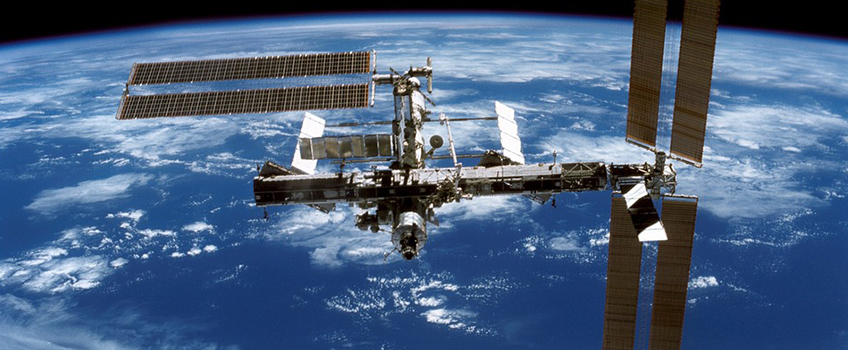Stockton University Students to Design Experiments for Spaceflight in Mission 11

International Space Station
For Immediate Release
Contact: Maryjane Briant
News and Media Relations Director
Galloway, N.J. 08205
Maryjane.Briant@stockton.edu
(609) 652-4593
stockton.edu/media
Galloway, N.J. - Students at Stockton University have been accepted for Mission 11 of the Student Spaceflight Experiments Program (SSEP) through the National Center for Earth and Space Science Education. This program takes experiments designed by students (grades 5 -16) to the International Space Station for experimentation in the microgravity environment.
“I am very happy and honored to let you know that the National Center for Earth and Space Science Education has approved your implementation plan for SSEP Mission 11 to the International Space Station,” said Jeff Goldstein, Center Director of the National Center for Earth and Space Science Education and Institute Director of the Arthur C. Clarke Institute for Space Education, in announcing the selection. “To the Stockton community, welcome aboard America's Space Program.”
Up to 30 undergraduates will be selected to compete on 10 three-person teams, mentored by Stockton faculty. Students will do research and design experiments that may involve physical, biological, chemical and/or physiological testing in microgravity (weightless) conditions. Experiments may involve various fields, including biology, chemistry, physics and engineering, and could include research into areas such as seed germination, cell cycles, crystal growth, polymer formation, viscosity, elasticity and manufacturing.
“This project represents Stockton’s commitment to faculty-mentored student research, particularly at the undergraduate level, which is one of the most distinctive aspects of our interdisciplinary, hands-on approach to education,” said Lori Vermeulen, provost and vice president for Academic Affairs, who is also a professor of Chemistry.
The teams are expected to produce between 10-15 experimental proposals, which will be judged by a Stockton review panel this fall. Three finalists would be submitted to the National Center for Earth and Space Science Education (NCESSE) for final selection, based on flight suitability within the constraints of the portable laboratory rack systems provided by Nanoracks LLC, and how well the experiment fits into the flight’s overall mission.
After a flight safety review by NASA, the winning design will fly in spring/summer 2017. The student experiment will be transported to the International Space Station using the SpaceX Dragon vehicle.
The flight will launch from Cape Canaveral, Fla., and members of the Stockton team are expected to be able to attend, said Dean Peter Straub of the School of Natural Sciences and Mathematics (NAMS).
Once the vehicle is docked, the student experiment will be transferred to ISS where mission specialists will conduct the experiments using the protocols specified by the student teams and agreed to in advance by NCESSE, NanoRacks, and NASA. NanoRacks was formed in 2009 to provide quality hardware and commercial services for the U.S. National Laboratory onboard the ISS.
To participate at Stockton, students can be from any major as long as they have an interest in science and space travel, according to Straub, who is director of the community portion of the program. The faculty team is led by Jason Shulman, associate professor of Physics, and includes Tara Harmer Luke, associate professor of Biology, Pamela Cohn, assistant professor of Chemistry, Norma Boakes, associate professor of education and Melissa Zwick, assistant professor of Biology.
The Mission 11 project at Stockton is a partnership between NAMS, the Stockton Science, Technology, Engineering and Mathematics (STEM) Collaborative, the School of General Studies and the School of Education.
Students will receive course credit through the School of General Studies. The student teams will operate under the General Natural Sciences and Mathematics (GNM) curriculum as a learning community with the goal of increasing enthusiasm for STEM-based learning.
After the design phase and space flight, students will analyze the samples returned to Earth. Stockton students can present results at the SSEP National Conference at the Air and Space Museum in Washington, D.C.
Students from the Greater Egg Harbor School District will also learn from the project, as part of Stockton’s commitment to STEM education and community outreach. A mission patch design competition will be held at both Stockton and the partner schools to produce a patch design that will also be on the ISS and serve as the project’s logo.
Patricia Weeks, director of the Southern Regional Institute & Educational Technology Training Center (SRI & ETTC) at Stockton, which trains teachers on integrating technology in the classroom, will work with Norma Boakes, associate professor of Education, and Tara Luke, Biology associate professor, on K-12 outreach. Stockton students who worked on the space project, particularly those in the School of Education, will present programs to younger students.
“The Student Spaceflight Experiments Program fits well into Stockton’s vision for our students to develop critical thinking skills and an understanding of the scientific method as well as to participate in serious undergraduate research,” Straub said.
The NCESSE, headed by Goldstein, provides national science education initiatives focusing on earth and space. No tax dollars are directly provided by NASA or any other federal agency to the SSEP. Funding comes from schools districts, foundations, non-profit funding organizations, and private sector businesses, Goldstein noted.
Stockton will pay $24,000, all of which was raised by the School of Natural Sciences & Mathematics (NAMS). “We are still fundraising both internally and externally, especially for added travel costs,” Straub said. To help support this project and NAMS, visit www.stockton.edu/nams.
The Student Spaceflight Experiments Program (http://ssep.ncesse.org) is undertaken by the National Center for Earth and Space Science Education (NCESSE; http://ncesse.org) in partnership with Nanoracks, LLC (http://www.nanoracks.com.)
This on-orbit educational research opportunity is enabled through NanoRacks, LLC, which is working in partnership with NASA under a Space Act Agreement as part of the utilization of the International Space Station as a National Laboratory.
For more information about Stockton University, visit Stockton.edu.


